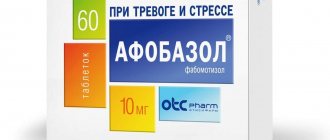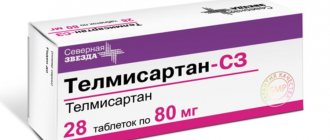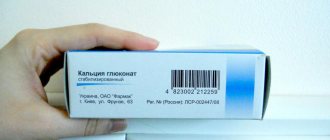Side effects
When iodoform is used externally, the risk of developing system-wide side effects is minimal. With hypersensitivity, you may experience:
- Itching in the treated area
- Rash, hives
- Anaphylaxis.
Inflammatory processes develop in the salivary glands, maxillary sinuses, and nasopharynx extremely rarely. This phenomenon is called iodism.
Patients noted the following symptoms:
- Hypersalivation - excessive salivation
- Rhinorrhea – nasal discharge
- Pharyngitis, laryngitis, bronchitis
- Laryngeal edema
- Gastrointestinal tract dysfunction
- Inflammation of the conjunctiva.
There is no specific treatment. It is recommended to discontinue iodoform and use another antiseptic.
General overview
Turunda in dentistry is a piece of gauze that is soaked in iodoform.
This is an antiseptic substance that has a characteristic odor and taste. Iodoform is yellow in color, so the impregnated materials have a light yellow tint. Also called turundas are cotton or gauze swabs that are temporarily placed with a medicinal substance in the tooth socket.
Turunda is used in different cases, but its main tasks are as follows:
- stop bleeding;
- accelerate wound healing in the hole;
- minimize drying out of the hole;
- prevent the growth of bacteria in the hole;
- for abscesses - to remove pus.
If bleeding does not stop for a long time after tooth extraction, then installing a tampon with medicine is a mandatory process.
Analogs
Analogs in the class of antiseptic substances, but with other active ingredients are:
Chlohexidine bigluconate
Transparent solution, manufacturer Monfarm, Ukraine. The price of a 100 ml bottle ranges from 9 to 15 rubles.
Used for treating wound surfaces, including in dentistry. The drug is not used for fungal diseases. Not produced in dry form. In surgery, applications with chlorhexidine are used on the wound surface.
Pros:
- Non-toxic
- Does not irritate fabrics.
Minuses:
- Does not affect fungi, yeast.
Dioxidine
Yellow solution, manufacturer Farmak, Ukraine. It has a powerful aseptic, anti-inflammatory, analgesic effect. The drug is used to treat wound surfaces, cavities and pockets. The price for 1 ampoule of 10 ml is 485 rubles.
Pros:
- Effective on most pathogenic microorganisms, including Pseudomonas aeruginosa
- Does not irritate fabrics.
Minuses:
- Toxic
- Prohibited for the treatment of pregnant and lactating women.
Myths and legends of endodontics: iodoform
Preparations containing iodoform are widely used in Russia in the treatment of apical periodontitis, despite the obvious lack of scientific information confirming the effectiveness of their use in endodontics.
The purpose of this article is a brief analysis of scientific publications concerning the effectiveness of iodoform preparations in the fight against endodontic infection.
Iodoform has been shown to have a short-term antimicrobial effect and quickly loses its effectiveness upon contact with organic substances.
In addition, adding iodoform to calcium hydroxide paste does not increase its antibacterial activity, but may cause undesirable effects. Based on the above, the author does not recommend the use of iodoform as a drug for the treatment of apical periodontitis.
For a long time, dentists believed in the wonderful properties of iodoform, especially in its wide antibacterial spectrum and duration of action: even long after its use, a characteristic odor is felt when the canal is opened!
Iodoform gained the greatest popularity in South America under the influence of Dr. O.A. Maisto, the father of South American endodontics and pediatric dentistry. Until now, many pediatric dentists around the world use Maisto paste (Maisto OA, Capurro MA, 1964) containing iodoform, which they prepare ex tempore, to fill the canals of baby teeth. Doctors are mainly attracted by the ability of iodoform-containing pastes to dissolve without disturbing the physiological resorption of the roots of primary teeth (Maisto OA, Erausquin J., 1965).
For many years, iodoform-containing pastes have been recommended as an antiseptic (Walton JG et al., 1989) due to the release of iodine upon contact with exudate or endodontic infection (Pucci FM, 1945; Castagnola L., Orlay HG, 1952).
Some doctors believe so much in the antibacterial properties of iodoform that they even add it to AH 26 (from personal observations in Israel and numerous stories from Argentine and Brazilian doctors). And in Russia, iodoform was even mixed into phosphate cement (from Internet revelations).
In 1999, Daniel, Jaeger and Machado, in their review article “Use of Iodoform in Endodontics,” found no laboratory or clinical studies to justify the use of iodoform in the treatment of apical periodontitis! And so began the verification of this old legend...
So, what do we know about iodoform?
Iodoform (triiodomethane - CHI3; molecular weight - 393.78; atomic weight - 126.9044) - powder with bright hexagonal crystals of lemon yellow color, with a penetrating persistent odor, poorly soluble in water (1:10,000), soluble in alcohol (1:60) and on air (1:75).
Iodoform is soluble in fatty acids, unstable and easily decomposes when interacting with organic substances. The antibacterial effect of iodoform is based on the mechanism of its decomposition upon contact with organic matter, as a result of which iodine is released (Pucci FM, 1945).
Thus, the smell of this compound has nothing to do with its antibacterial activity! Substances that contain iodine are actively used for disinfection in dentistry. Iodine makes them highly effective by precipitating proteins and oxidizing enzymes. In the presence of organic and inorganic substances, iodine activity is quickly lost (Estrela C., 2004).
Evidence of this fact can be found in the endodontic literature. Thus, in a 1990 study, it was proven that iodine-based preparations destroy microbes in a very short period of time (Safavi E. et al., 1990). These data were confirmed in a recent study (Lin S. et al., 2009).
Markus Haapasalo's group and his best student Isabella Portenier took this topic seriously - she defended her PhD degree on this research. In a series of their works (Haapasalo HK et al., 2000; Portenier I. et al., 2001) it was shown that powdered dentin very quickly neutralizes the antibacterial effect of iodine-containing drugs, and the organic dentin matrix and heat-killed E. faecalis and C. albicans slowly inhibit this effect.
Indirect evidence that iodoform has a short-term antibacterial effect and is not as broad a spectrum of action as calcium hydroxide is the market for endodontic drugs, where they do not sell pure iodoform, but only its compound with calcium hydroxide: Metapex, Vitapex, Diapex, Endoflass. But there are many preparations of pure calcium hydroxide (Belyaeva T.S., Bolyachin A.V., 2010).
However, clinicians want to see microbial studies! C. Estrela (2006) used microbial cultures of S. aureus, E. faecalis, P. aeruginosa, B. subtilis and C. albicans on an agar diffusion test. The study examined the following antibacterial drugs:
1) Ca(OH)2 in physiological solution;
2) Ca(OH)2 + iodoform;
3) iodoform.
The results of the study showed that the effectiveness of the first and second groups was approximately the same, while iodoform in its pure form had no effect!
When testing for the direct effect of the drug, the following results were obtained: the effectiveness of the first and second groups was also the same, and iodoform in its pure form had no effect on either the mixture of microbes or B. subtilis individually.
Conclusion: Iodoform does not improve the antimicrobial properties of calcium hydroxide.
A Brazilian group of researchers tested the activity of calcium hydroxide/camphor paramonochlorophenol/glycerol pastes containing different amounts of iodoform on obligate anaerobic microorganisms. A study showed that the addition of iodoform did not change the antibacterial properties of the paste (Siqueira Jr JF et al., 1997).
Another study was conducted in the field of pediatric dentistry (Reddy S., Ramakrishna Y., 2007). 23 species of bacteria were isolated from the canals of primary molars with apical periodontitis. The following drugs were tested on the agar test:
1. zinc oxide eugenol (ZOE);
2. zinc oxide-eugenol and formocresol (ZOE + FC);
3. calcium hydroxide in sterile water (Ca(OH)2 + H2O);
4. zinc oxide and camphor phenol (ZO + CP);
5. calcium hydroxide and iodoform (Metapex);
6. Vaseline (control).
The results of the study showed that, with the exception of Vaseline, Metapex showed the weakest effect!
A similar result was obtained in 2008 (Blanscett ML et al., 2008). We used mixtures of calcium hydroxide powder with saline solution - UltraCal XS and Vitapex. Testing was carried out on 6 endopathogens using the agar diffusion test. Vitapex has been shown to have the smallest zone of inhibition!
In other words, Vitapex and Metapex performed worse than pure calcium hydroxide powder in the studies listed!
As a speculative hypothesis, I can put forward the following: silicone oil in these preparations disrupts the action of calcium hydroxide, since there is no dissociation. However, laboratory studies cannot completely simulate[m1] the clinical situation, and the antimicrobial effect of iodine preparations cannot be completely denied.
In the literature you can find articles about the short-term, but strong (Kvist T. et al., 2004) and deep (penetration into the dentinal tubules) effect of iodine-containing preparations (Fuss Z. et al., 2002).
At the same time, the negative properties of iodine-containing drugs include:
· possible allergic reactions (Hensten A., Jacobsen N., 2005; Ijima S., Kuramochi M., 2002);
· staining of tooth tissue (Kupietzky A. et al., 2003);
· the use of iodine preparations disrupts the adhesion of epoxy sealers to dentin (Bartanovsky E., Solomonov M. et al., 2014).
So, iodoform-based drugs do not have a long-term and broad spectrum of action, in addition, they can cause allergic reactions and disrupt the adhesion of epoxy sealers, so I do not recommend their use as first-line drugs for apical periodontitis.
PS The article was published in the journal “Endodontics”. We thank editor-in-chief Alexey Bolyachin for the material provided.
Reviews
To use or not to use a tampon after tooth extraction? Only the attending physician should answer this question, since the use of such materials has its own indications.
If you have experience using turundas, we will be glad to see your feedback.
If you find an error, please highlight a piece of text and press Ctrl Enter.
The medicine contains 98% of the active substance Triiodomethane. The powder is insoluble in water, slightly soluble in gasoline, alcohol, organic oils and easily soluble in ether.
Rules of application
The principle of use itself is quite simple. If we are talking about a tooth socket after tooth extraction, then the turunda is pre-twisted in the form of a tourniquet.
It is important that it completely reaches the bottom of the hole. If there is free space left in the hole, then this is dangerous due to the development of inflammation due to the active proliferation of bacteria in the blood clot. Installation algorithm:
- A thorough examination of the hole. There should be no bone fragments left in it, because this can cause pus and inflammation.
- Turundutak is injected into the cleaned hole so that it “sits” tightly over the entire area.
- Once it is fully seated, the patient should bite down on it well to ensure that any remaining voids are filled.
After installation, the doctor must indicate the exact time at which the gauze cannot be removed. In case of inflammatory processes, medications can also be placed in the hole along with soaked gauze. In this case, you cannot remove the turunda for 1-2 weeks, but it all depends on the situation.
If the tooth extraction was successful, then the hole is simply “closed” with a sterile gauze swab. It can be removed after 20-30 minutes.
If you keep such a tampon for more than the specified time, it will become a real provocateur for the growth of bacteria. In addition, it will prevent the formation of a clot.
Manufacturing
To make turunda for dental purposes, you need to know the proportions of dilution of iodoform, since this substance has a crystalline structure. Iodoform does not mix well with ordinary water. Therefore, it practically does not dissolve.
Medical ether is used to fill wounds after tooth extraction. The main thing is to maintain the proportion - 1 part iodoform to 10 parts ether.
For the turunda itself, cut out a small gauze ribbon. Its length can be different, because it all depends on the depth and width of the hole. The finished piece is impregnated with the composition.









